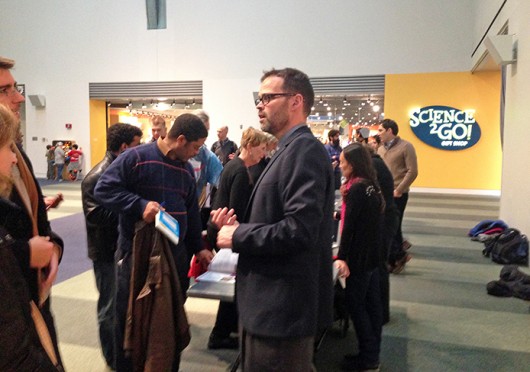
Lloyd Knox, a professor in the physics department at the University of California at Davis, spoke about how the universe is expanding at COSI Feb. 24.
Credit: Matt Homan / Lantern reporter
It’s not hard to understand the universe is big. Trying to explain how it expands is another issue entirely.
Lloyd Knox, a professor in the physics department at the University of California at Davis, attempted to do just that during his hour-long lecture Sunday at Columbus’ Center of Science and Industry, more commonly known as COSI.
“It’s not that galaxies are moving faster than the speed of light — matter cannot travel that fast. The distance between us and certain regions is increasing at a rate more than the speed of light. Space is being created between the matter,” Knox said in response to an audience question about how light can be 46 billion light years away in a universe that’s only about 14 billion years old.
An audience of more than 140 gathered in COSI’s Extreme Screen Theatre to observe Knox’s presentation, “Confirmed Truths and Remaining Mysteries Regarding the Origin of the Universe,” said Kate Storm, COSI’s director of strategic initiatives. Interested spectators were also invited to meet Knox and scientists from Ohio State’s Center for Cosmology and Astroparticle Physics in the museum’s atrium after the lecture.
Director of CCAPP and OSU physics and astronomy professor John Beacom introduced Knox, and said one of CCAPP’s primary missions is to “bring exciting results to the public and to the children.”
The exciting results in this case are the analysis Knox has developed from using data collected by the Planck satellite, which was launched in 2009. Knox works with other physicists to map the oldest light in the universe, a “cosmic background” imprint from just about 400,000 years after the Big Bang. That analysis helps scientists understand the size, structure and expansion of the universe.
Tatyana Sinetskaya. a second-year in international studies, said she was impressed by Knox’s lecture.
“It’s awesome somebody so knowledgable can explain to others in simple terms, so even those of a young age are interested,” Sinetskaya said.
Nurturing that interest among children is important, said Brittney Curtis, a fourth-year in physics and astronomy.
“I love astronomy. The images we get from studying the universe are so beautiful that they help get the younger generation involved,” Curtis said.
Curtis, who is also president of OSU’s Society of Physics Students, said it’s “fantastic that we (had) such a famous physicist come to Columbus and work with Ohio State to interest the public in (cosmology).”
Knox told The Lantern after the lecture the work he does is “really cool,” but admitted that, like any job, he doesn’t always feel that way. Speaking to the public is a part that he enjoys, he said.
“Day to day, you know, it’s work. But when I come here to talk to a group that’s here because they’re interested in it, I kinda pick up their enthusiasm and curiosity and wonder and it’s just fun,” Knox said.


